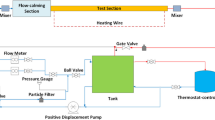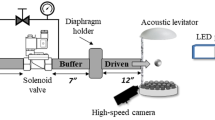Abstract—
The results of the measurement of the surface temperature of a flat plate in a supersonic air-droplet flow are presented. The plate made of duralumin was mounted vertically in the working channel of an aerodynamic setup. The droplets of a liquid (distilled water) were pulverized into an air flow in a plenum chamber through centrifugal atomizers. The mass concentration of the liquid was about 0.36 and 0.27%, the mean droplet diameter according to Sauter was about 110 μm, and the freestream Mach number M = 2.5 and 3.0. The surface temperature was measured by an IR imager. The measured plate surface temperatures for the case of single-phase air flow (without droplets) were compared with those for the air-droplet flow at the same parameters (with respect to the air) in the plenum chamber. To intensify the droplet sedimentation on the plate a shock generator in the form of a wedge was mounted vertically ahead of the plate.




Similar content being viewed by others
REFERENCES
A.Yu. Varaksin, “Gas-solid flows past bodies,” High Temperature 56(2), 275–295 (2018).
Heat Transfer Theory.Terminology Ed. by B.S. Petukhov (Moscow, 1967) [in Russian].
H. Schlichting, Boundary Layer Theory (Mc Graw-Hill, New York, 1968).
Yu.V. Lapin, Turbulent Boundary Layers in Supersonic Gas Flows (Nauka, Moscow, 1970) [in Russian].
A.I. Leont’ev, “Gasdynamic methods of temperature stratification (a review),” Fluid Dynamics 37(4), 512—529 (2002).
Yu.A. Vinogradov, A.G. Zditovets, and M.M. Strongin, “Experimental investigation of the temperature stratification of an air flow through a supersonic channel with a central body in the form of a porous permeable tube,” Fluid Dynamics 48(5), 687–696 (2013).
A.I. Leontiev, A.G. Zditovets, Y.A. Vinogradov, M.M. Strongin, and N.A. Kiselev, “Experimental investigation of the machine-free method of temperature separation of air flows based on the energy separation effect in a compressible boundary layer,” Exp. Therm. Fluid Sci. 88, 202–219 (2017).
A.I. Leontiev, A.G. Zditovets, N.A. Kiselev, Y.A. Vinogradov, and M.M. Strongin, “Experimental investigation of energy (temperature) separation of a high-velocity air flow in a cylindrical channel with a permeable wall,” Exp. Therm. Fluid Sci. 105, 206–215 (2019).
A.I. Leontiev, S.S. Popovich, Y.A. Vinogradov, and M.M. Strongin, “Experimental research of supersonic aerodynamic cooling effect and its application for energy separation efficiency,” in: Proc. 16th Int. Heat Transfer Conf., IHTC-16. V. 212244. Beijing, China,2018, pp. 1–8.
D.E. Khazov, “Numerical investigation of machine-free energy separation of compressible gas flows,” Teplovye Protsessy v Tekhnike 10(1–2), 25–36 (2018).
M.S. Makarov and S.N. Makarova, “Efficiency of energy separation at compressible gas flow in a planar duct,” Thermophysics Aeromechanics 20(6), 757–767 (2014).
V.S. Zhukovskii, V.A. Madievskii, and K.I. Reznikovich, “Own temperature of a wall in a supersaturated vapor flow,” Teplofiz. Vys. Temp. 4(3), 399–406 (1966).
L.A. Ignat’evskaya, “Investigation of the two-phase boundary layer on a plane wall,” Moscow Energy Institute, Dissertation (1971).
A.I. Leontiev, A.N. Osiptsov, and O.D. Rybdylova, “The boundary layer on a flat plate in a supersonic gas-droplet flow. Influence of evaporating droplets on the temperature of an adiabatic wall,” High Temperature 53(6), 865—872 (2015).
G.M. Azanov and A.N. Osiptsov, “The effect of fine evaporating droplets on the adiabatic wall temperature in a compressible two-phase boundary layer,” Fluid Dynamics 51(4), 498–506 (2016).
I.V. Golubkina and A.N. Osiptsov, “The effect of admixture of non-evaporating droplets on the flow structure and adiabatic wall temperature in a compressible two-phase boundary layer,” Fluid Dynamics 54(3), 349–360 (2019).
Funding
The study was carried out within the framework of the State theme АААА-А16-116021110200-5 of Institute of Mechanics of Moscow State University with the partial support of the Russian Foundation for Basic Research (project 17-08-00130).
Author information
Authors and Affiliations
Corresponding author
Ethics declarations
The Authors declare no potential conflicts of interest with respect to the research, authorship, and/or publication of this article.
Additional information
Translated by M. Lebedev
Rights and permissions
About this article
Cite this article
Vinogradov, Y.A., Zditovets, A.G., Kiselev, N.A. et al. Measurement of the Adiabatic Wall Temperature of a Flat Plate in a Supersonic Air-Droplet Flow. Fluid Dyn 55, 701–707 (2020). https://doi.org/10.1134/S0015462820050146
Received:
Revised:
Accepted:
Published:
Issue Date:
DOI: https://doi.org/10.1134/S0015462820050146




